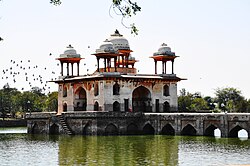Narnaul | |
|---|---|
 Jal Mahal of Narnaul, Haryana | |
| Coordinates: 28°02′40″N76°06′20″E / 28.04444°N 76.10556°E | |
| Country | |
| State | Haryana |
| District | Mahendragarh |
| Seat | Government of Haryana |
| Elevation | 318 m (1,043 ft) |
| Population (2011) | |
• Total | 145,897 |
| Languages | |
| • Official | Hindi, Haryanvi [1] & English registration_plate = HR-35 xxxx (for non-commercial vehicles) HR-66 xxxx (for commercial vehicles) |
| Time zone | UTC+05:30 (IST) |
| Postal code of India | 123001 |
| Area code | 01282 |
| ISO 3166 code | IN-HR |
| Sex ratio | 901 ♂/♀ |
| Climate | Cw (Köppen) |
| Precipitation | 570 millimetres (22 in) |
| Avg. summer temperature | 38 °C (100 °F) |
| Avg. winter temperature | 04 °C (39 °F) |
| Website | mahendragarh |
Narnaul is a city, a Municipal Council, and location of headquarters of the Mahendragarh district in the Indian state of Haryana. It is located in the National Capital Region of India.







